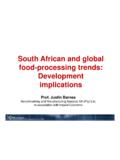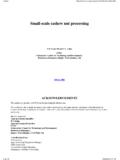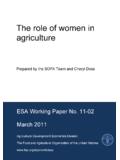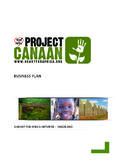Transcription of Rwanda Economic Update - World Bank
1 SEEDS FOR HIGHER GROWTH Spring Edition April 2011 The World Bank Rwanda Economic Update PREFACE The Rwanda Economic Update reports and synthesizes key Economic developments in the past six months in Rwanda s economy. It places them in a medium-term and regional context, and will increasingly assess the implications of these developments and policies for the outlook of Rwanda s economy. The Update will cover in each edition a special feature on a selected topic. It is intended for a wide audience, including policy makers, business leaders and other market participants, and the community of analysts engaged in Rwanda s economy. The Rwanda Economic Update was prepared and compiled by the Poverty Reduction and Economic Management team at the World Bank Country Office in Rwanda , under the leadership of Birgit Hansl, Senior Economist: Peace Aimee Niyibizi ( Economic Update section), Loraine Ronchi and Valens Mwumvaneza (agriculture section).
2 The report also benefited from guidance and advice provided from Wolfgang Fengler, Lead Economist, Kathie L. Krumm, Sector Manager and Omowunmi Ladipo, Country Manager. In addition, the report benefited from peer reviewer inputs by Stephen Mink, Lead Economist and Anton Dobronogov, Senior Economist. For more World Bank information on Rwanda : For more information about the World Bank and its activities in Rwanda , please visit: If you would like to be included into the email distribution list for this semi-annual series and related publications, please contact For questions and comments relating to this publication, please contact iii | P a g e ACRONYMS BNR Banque Nationale du Rwanda (Central Bank of Rwanda ) CAADP Comprehensive Africa Agriculture Development Programme CIP Crop Intensification Program COMESA Common Market for Eastern and Southern Africa CPI Consumer Price Index DRC Democratic Republic of Congo EAC East African Community EDPRS Economic Development and Poverty Reduction Strategy FWC Fully Washed Coffee GDP Gross Domestic Product ha hectare kcal kilocalorie kg kilogram LWH Land Husbandry, Water Harvesting and Hillside Irrigation NAP National Agricultural Policy NISR National Institute of Statistics of Rwanda PSTA Strategic Plan for Transformation of Agriculture Rwf Rwandan Franc RDA Recommended Dietary Allowance SSA Sub-Saharan Africa USAID United States Agency for International Development WDI World Development Indicator iv | P a g e TABLE OF CONTENT Preface.
3 Ii Acronyms .. iii Table of content .. iv List of figures .. v List of Boxes .. v List of tables .. v Executive Summary .. vi Part 1: Seeds for Higher 1 Agriculure s Strategic role .. 1 Agriculture Growth And Productivity .. 3 Food Crops and Food Security .. 4 Food Crops .. 4 Food Security .. 5 Export Crops .. 7 Horticulture .. 7 Tea .. 8 Coffee .. 9 Seeds for Growth .. 10 Soil Fertility and Erosion Issues .. 10 Irrigation Needs .. 11 Post Harvest Management .. 12 Access to Financial Services .. 12 Part 2: Recent Economic DevelopmentS .. 13 Real Sector Trends .. 13 Price Trends .. 15 Fiscal trends .. 16 External Sector Trends .. 19 Exchange Rate Trends .. 21 Monetary Policy and Credit Trends .. 22 Data Sources and References .. 24 Annex 1: Growth Trends in Foods Crops (2004-2010) .. 25 Annex 2. Gross Domestic Product by Activity at constant 2006 prices (Rwf billion) .. 27 Annex 3. Government Priority Areas of Spending.
4 28 v | P a g e LIST OF FIGURES Figure 1. GDP Growth by Sector (Percent) .. vi Figure 2. Rwanda s Real Growth Compared to EAC and SSA (Percent) .. vii Figure 3. GDP Composition (Percent) .. 3 Figure 4. Agricultural Productivity Trends in Rwanda .. 4 Figure 5. Growth and Productivity Comparison .. 4 Figure 6. Food Availability Indicators in Rwanda .. 6 Figure 7. Tea Export Values and Prices .. 8 Figure 8. Coffee Export Values and Prices .. 9 Figure 9. Growth in the Agriculture Sector (Percent) .. 14 Figure 10. Growth in the Services Sector (Percent) .. 15 Figure 11. Growth in the Industry Sector (Percent) .. 15 Figure 12. Inflation Trends 2007-2010 .. 16 Figure 13. Domestic Fuel Price Trends in 2010 (Rwf) .. 16 Figure 14. Average Price of Rwanda Coffee, 2010 (US$) .. 19 Figure 15. External Developments (Percent of GPD) .. 21 Figure 16. Nominal Exchange Rate of Major Currencies, end March=100 .. 22 Figure 17. Lending and Deposit Rates (Percent).
5 22 Figure 18. Money Market Operations (Billion of Rwf) .. 23 LIST OF BOXES Box 1: CIP and Growth in Food Crops .. 5 Box 2: Coffee Production Cycle .. 10 LIST OF TABLES Table 1. Employment Trends (Percent) .. 2 Table 2. Imports of Food Products (Percent) .. 7 Table 3. Insurance Activities in Rwanda (Billion of Rwf) .. 14 Table 4. Government Budget 2009/10 and 2010/11 (Billion of Rwf) .. 17 Table 5. Main Export Products (US$ Million) .. 19 Table 6. Informal Cross Border Trade (Million US$) .. 20 Table 7. Evolution of Imports by Economic Classification, Value in Million of US$ and Volume in Tons 20 Table 8. National Park Activities .. 21 Table 9. Variations of EAC Currencies/Rwandan Franc (+Appreciation/-Depreciation) in 2010 .. 22 Table 10: Compound Growth in Food crops (Percent) .. 25 vi | P a g e EXECUTIVE SUMMARY The current edition of the Rwanda Economic Update is titled Seeds for Higher Growth and specially features the agriculture sector.
6 The importance of agriculture s contribution to growth in Rwanda remains considerable, despite the emergence of other significant growth drivers, such as services. Rwanda s agriculture sector will play an essential role in attaining the country s development vision of sustainable growth and increased poverty reduction, due to its employment weight. The agriculture feature of this Update edition outlines key channels through which agriculture contributes to the economy. The second part of the Update provides the regular overview of recent macroeconomic developments. While the special feature on agriculture will analyze the evolving role of the sector over the past five years, the second part on recent Economic developments will focus on events during 2010. The vision of Rwanda is to transform itself from a subsistence agricultural to a knowledge-based economy by 2020.
7 The achievement of this vision will require an intensification and market-orientation of agriculture on the one hand and a diversification of the economy through a proliferation of non-agricultural sectors on the other hand. This brief assesses progress by Rwanda on both fronts. Agriculture is one of two key growth engines for Rwanda . The agricultural sector grew at an average of percent over the last five years (Figure 1), contributing about percent to the overall Gross Domestic Product (GDP). The sector occupies percent of the labor force and generates more than percent of the country s export revenues. The services sector established itself as a second growth engine, registering double digit growth between 2004 and 2008-albeit from a very low base--before being affected by the global slowdown.
8 In recent years, services marginally surpassed agriculture as the main contributor to GDP. Figure 1. GDP Growth by Sector (Percent) Source: National Institute of Statistics of Rwanda (NISR) Agriculture expenditure forms one of the priority expenditures of the Government of Rwanda s annual budget with focus on increasing productivity in the sector. Over the past three years, allocations to the agricultural sector have increased from percent of the budget in 2008 to percent in the 2010/11 budget. Together with agricultural related spending allocated to other institutions, Rwanda now complies with the 10 percent commitment made (Right scale) vii | P a g e under the Africa Union s Comprehensive African Agriculture Development Program (CAADP) compact, of which Rwanda was the first signatory. The main recipient of the agriculture budget shares were the Government s flagship programs, such as the Crop Intensification Program (CIP) and the Land Husbandry, Water Harvesting and Hillside Irrigation (LWH) Project, the latter being also supported with donor funds.
9 The strategic focus on agriculture, through continued public investments, has contributed to marked productivity increases and solid agriculture growth rates over recent years. However, in order to sustain these productivity increases in the future, and in order to fully realize the growth potential for the agriculture sector, a number of challenges would need to be addressed. These challenges include the need to stronger focus on: (i) Reducing dependency on rain-fed agriculture through greater use of different models of irrigation; (ii) Better erosion control and integrated soil fertility management; (iii) Diversifying agriculture production, in particular agricultural export goods, for example in areas of horticulture and flowers, (iv) Changing the skills profile of people employed in agriculture, to foster the creation of increased agricultural off-farm employment such as agro-processing and other value chain activities, and (v) Developing a market-based food crop distribution system to contribute to country-wide food security.
10 Continued agriculture growth through the channels outlined above will benefit agriculture growth and increase food security, but most of all will sow the seeds for higher overall Economic activity. Overall, Rwanda s economy is growing at a healthy rate, percent in 2010, two percent higher than the East African Community (EAC) and even more than Sub Saharan Africa (SSA) (Figure 2). During 2010 the services and industrial sectors progressed in their growth recovery, while growth in the agricultural sector slowed down marginally. Figure 2. Rwanda s Real Growth Compared to EAC and SSA (Percent) Source: World Development Indicator (WDI) and International Monetary Fund The country s macroeconomic framework was remarkably stable, given the difficult external post-crisis environment and Rwanda s position as a highly import-dependent land-locked country.


















